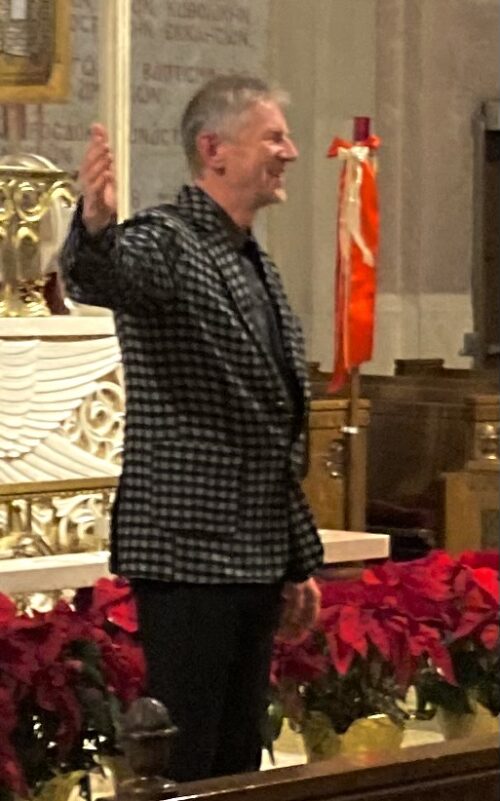Russian sacred choral music – with its brooding bass lines and treble writing that reaches for the stratosphere – is express route to one’s soul, raising the question: Why is Alexander Levine one of the few composers to tap into it to address our current ills? Perhaps because all-things Russian are perceived by some to be the root of the current global unrest? Let’s not be small-minded here. The generically titled Vigil for Peace, premiered by the Clarion Choir over the cusp of the new year (Dec. 31 and Jan. 1) at New York’s Archdiocesan Cathedral of the Holy Trinity, came from a world aiming at transcendence with grand sweep and inner detail. This was among the most singular new-music premieres so far this season.

The 12-section work for unaccompanied choir (dubbed “selections” from what may be a larger work) was preceded by secular Rachmaninoff choral works that set the tone for how this compositional language can be harnessed for western ears and in counterpoint to modern times. Texts were liturgical and in Russian. References to the Russia-Ukraine war were not explicit. Yet the piece was something that listeners maybe didn’t know they needed.
“My connection to the Ukraine runs deep,” wrote the 68-year-old Russia-born but U.K.-based composer in the program notes, citing the Antiphon Stepénna as a spiritual and thematic basis for the piece. “The lyrical beauty of the ancient text inspired me to compose music intricately woven with various aspects of Ukrainian culture, seeking to preserve and celebrate the essence…. ” Few listeners at the concerts were likely to specifically hear such particulars, but the composer’s process as such appears to have put him in a fevered state of inspiration.
The antiphon begins “I direct the eyes of my heart towards Thee….” and proceeds into expressions of repentance that may lack special significance to American ears at the New Years Eve performance. However, the composer’s innate relationship to the text in this 10th movement was that of deep reverence. The hymn-like opening of the movement was largely chordal. Though rhythmically wedded to the words, vocal lines had a lyrical buoyancy that never allowed the music to feel like doctrine, but as a catalyst for spiritual communion. At times, the music scaled back to a chant-like level of distillation. The text shading came from the inner voices, changing the complexion of the music’s surfaces but never dominating it. After so much sustained reverence, the final moments of the movement – “It befits the holy spirit to reign” – were marked by a swelling harmonic richness that created spiritual narrative, not to mention musical shape.
The most striking moments in nearly all of the movements were the final resolutions. Never were they predictable. Never did you know where they were going until they happened. But while musically ingenious, the resolutions also served a symbolic function. The piece is about resolving crisis, and while the world stands powerless over what is happening in the Ukraine, there’s a resolution to be had within one’s self, not accepting or enabling the war, but living our lives and determining what can be done from afar.
Levine’s east-to-west background put him in a unique position to write this piece, whose harmonies had less of a British Anglican tinge than some of his works. Levine inhabited the Russian liturgical manner as a first language – not a throwback but a look back – occasionally exercising the option to use more spare modern chords and to have ideas grow out of each other in a ways that liturgical music from this world seem not to permit.
The all-professional Clarion Choir under Steven Fox of course played a key role here, being perhaps the best choir in New York and one that is able to summon the kind of vocal richness needed for this music with a linguistic authority that offered great clarity to those following on the text. In more chant-like moments, the vocal inflections highlighted the dips and turns that some more liturgical-based vocal groups might take for granted. And does this choir have some sort of volume knob that allows quick, seamless changes in dynamics?
Such effects were particularly heard in the concert’s all-Rachmaninoff first half. Smart programming there. The audience ears were warmed to the Russian choral sound and manner, but the music itself was not top-drawer Rachmaninoff and thus wasn’t going to make Levine suffer by comparison. In fact, one could ask if there’s a compelling reason to bring out the lightweight Six Choral Songs for Treble Voice Op. 15. Answer: The performances struck just the right balance of tidy ensemble and moderate tempos, allowing the music to reveal an unpretentious charm – and one that illuminated Rachmaninoff’s larger works in a way that Brahms’ similar Op 17 choral songs give one an entry point to his larger works.


